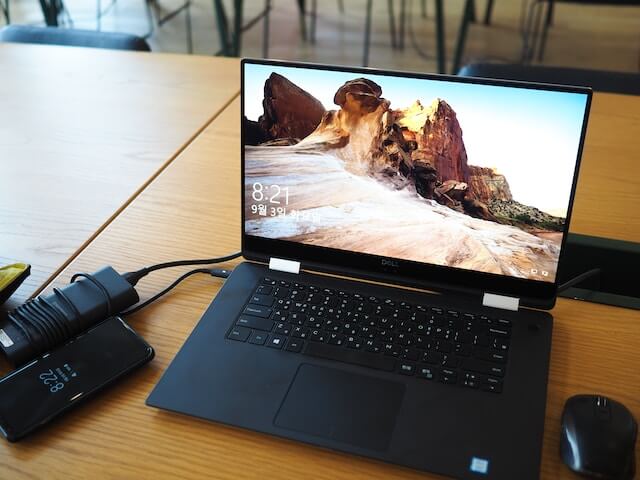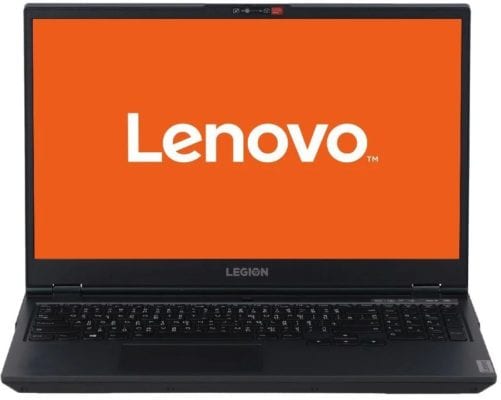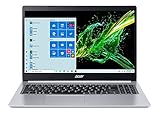ArcGIS Pro is a desktop Geographic Information System (GIS) application that will allow you to 2D maps and 3D scenes, as well as explore, visualize, and analyze data when you’re working with maps and geographical information. This kind of application requires serious computing power, but finding the best laptop for ArcGIS Pro won’t be easy.
Not only will you need to find a device that has a powerful processor, but you will also need a device with high memory, huge storage space, and a great display for properly visualizing and creating 2D maps or 3D scenes. Thankfully, there are good laptops out there that you can use for the software and we’re here to help you identify the best laptops available.
Recommendations for April 2024
- Lenovo Legion 5 – A powerful device that uses the 4th Gen AMD Ryzen that also runs silently.
- Acer Predator Helios 300 – An already fast and powerful device that can get more powerful with its Turbo Button.
- Dell Inspiron 15 7000 – A sleek and stylish silver laptop that offers great power and amazing features like Adaptive Thermals and Lid-Open Sensors.
- HP Envy 15 – A stylish and well-built device with a powerful processor and graphics, as well as a lightning-fast connection with Wi-Fi 6.
- ASUS TUF Gaming A15 – Sturdy and durable laptop also has powerful specs with its 4th Gen AMD Ryzen CPU and Nvidia GTX GPU.
- Acer Aspire 5 – A budget option that has solid specs and features.
- MSI Creator 17M – A high-performing device with powerful specs and an amazing 17.6-inch full HD screen.
- Apple MacBook Pro 16 – Sleek and powerful MacBook with 10th Gen Core processor and AMD Radeon Pro graphics.
- ASUS ZenBook Duo – Amazing laptop with powerful specs and two screens for increased productivity.
- Microsoft Surface Pro 7 – Thin and light 2-in-1 laptop that features amazing specs for great portability.
Best Laptop For ArcGIS Pro in 2024
Lenovo Legion 5 – Powerful But Silent Laptop
One of the best laptops to meet the ArcGIS Pro system requirements is the Lenovo Legion 5. Not only does it come with powerful specs but it is also one of the most discreet laptops on this list.
It features a 4th Generation AMD Ryzen 7 processor with 16 GB RAM and 512 GB SSD hard drive. It also comes with GeForce GTX 1660 Ti graphics, providing you with powerful specs that can do almost anything and run any programs or software without issues.
With these powerful specs, you can easily run the ArcGIS Pro program on this device and use it for creating 2D maps or 3D scenes. You also won’t have problems using this model for other tasks, including multitasking. The 15.6-inch display also makes it easier to create content on this laptop.
But what’s great about this device is that it operates silently. It comes with three power modes with the lowest setting allowing it to operate like a fanless laptop. But even at its full capacity, the fan noise is still mild, making it a great option if you like a discreet device to work with.
Recommended Configuration for Lenovo Legion 5
CPU: AMD Ryzen 7-4800H | Graphics: Nvidia GeForce GTX 1660 Ti | RAM: 16 GB DDR4 RAM | Screen: 15.6” Full HD IPS Display (1920 x 1080) pixels | Storage: 512 GB M.2 NVMe PCIe SSD | Operating System: Windows 10 Home | Battery Life: 6 hours | Weight: 5.41 lbs
Acer Predator Helios 300 – Provide Extra Power
As powerful as your laptop is, there will still be moments when you will require more power to properly complete a demanding task. This is what the Predator Helios 300 can offer with its Turbo Button.
It’s already a powerful device with its 10th Generation Intel Core i7 processor and Nvidia RTX 2060 GPU. It also features a 16GB dual-channel RAM and 512 GB SSD storage space.
These are already great specs that can provide enough juice to run demanding programs such as ArcGIS Pro and perform taxing activities like creating 3D content. But in case you find yourself still needing more power from your laptop, the Turbo Button will come in handy.
Pressing it will allow you to overclock the device’s GPU, providing you with more power in the process. This is a handy feature, in case you are doing something that is really demanding and you will need more computing power from your laptop.
It also has a 15.6-inch display, making it one of the best laptops for GIS software like ArcGIS Pro that you can get because of its power and features.
Recommended Configuration for Acer Predator Helios 300
CPU: Intel Core i7-10750H | Graphics: Nvidia GeForce RTX 2060 | RAM: 16 GB DDR4 RAM | Screen: 15.6” Full HD IPS Display (1920 x 1080) pixels | Storage: 512GB NVMe SSD | Operating System: Windows 10 Home | Battery Life: 4.5 hours | Weight: 5.07 lbs
Dell Inspiron 15 7000 – Stylish With Amazing Specs
The Dell Inspiron 15 7000 is not only one of the best laptops for ArcGIS Pro, not because of its specs and features, but also because of how stylish it looks.
It features a minimalist all-silver design that covers the all-aluminum chassis that this laptop uses. This shows it’s not only stylish but also durable and won’t break easily. But Dell didn’t just make it stylish, as the laptop also comes with an amazing CPU and GPU, featuring a 10th Gen Intel i7 processor and a GeForce GTX 1650 graphics.
It also features an 8GB RAM, 512 GB SSD hard drive, and a 15.6-inch display. These are great specs that will allow you to easily run any program or software, including GIS software, without any problems.
But what makes the Dell Inspiron 15 7000 good is it also comes with amazing features like the Adaptive Thermals which automatically adjust the laptop’s thermal profiles to provide comfort depending on how you use the laptop.
It also has a lid-open sensor that turns on the laptop once you open the lid, even if it’s completely turned off, for faster booting and allowing you to start working immediately. These great features make this an amazing laptop to have.
Recommended Configuration for Dell Inspiron 15 7000
CPU: Intel Core i7-10750H | Graphics: Nvidia GeForce GTX 1650 | RAM: 8 GB DDR4 RAM | Screen: 15.6” Touch WVA Display (1920 x 1080) pixels | Storage: 512GB M.2 PCIe NVMe SSD | Operating System: Windows 10 Home | Battery Life: 8 hours | Weight: 3.39 lbs
HP Envy 15 – Well-Built And Sleek With Great Specs
Another stylish laptop on this list is the HP Envy 15. The model we recommend comes with a light grey color with a minimalist design as only the laptop’s logo is visible from the outside, providing a sleek and high-end look.
The laptop also has an all-aluminum chassis, further making it more of a high-end laptop. The chassis also shows that this is a durable laptop and not just an elegant-looking one. But this laptop is not just well-built and stylish, it also possesses great specs.
The device features a 10th-generation Intel i7 processor with 16GB RAM and a 512 GB SSD hard drive. The laptop also has a GeForce GTX 1650 Ti graphics, providing you with a device that has enough power to perform taxing activities and run demanding programs or software.
It also has a 15.6-inch display that delivers bright and sharp images. This makes this one of the best laptop models you can use for the ArcGIS Pro since its specs can easily run the program and allow you to create 2D maps and 3D scenes easily.
Recommended Configuration for HP Envy 15
CPU: Intel Core i7-10750H | Graphics: Nvidia GeForce GTX 1650 Ti | RAM: 16 GB DDR4 RAM | Screen: 15.6” Full HD WLED-Backlit Multitouch Display (1920 x 1080) pixels | Storage: 512GB M.2 PCIe NVMe SSD | Operating System: Windows 10 Home | Battery Life: 6.5 hours | Weight: 4.74 lbs
ASUS TUF Gaming A15 – Tough With Powerful CPU
If you want a device that is strong and durable but can also offer great performance, then the ASUS TUF Gaming A15 is your laptop.
It’s a tough and sturdy laptop that can easily survive accidental falls, bumps, and shocks. The laptop has undergone extreme testing and has met the MIL-STD-810H standards, showing that this laptop won’t easily break down from short-distance falls.
This makes this model one of the most durable laptops on the list. But this laptop is not just tough, it also provides great performance. It features a 4th Gen AMD Ryzen 5 processor and a Nvidia GTX 1650 graphics.
The laptop also comes with 8 GB RAM and 512 GB SSD storage space, showing that this device has enough power to perform well regardless of the task you are doing or the program you are running.
Add a 15.6-inch display and you have one of the best laptops for ArcGIS Pro that you can get with its combination of specs and durability.
Recommended Configuration for ASUS TUF Gaming A15
CPU: AMD Ryzen 5 4600H | Graphics: Nvidia GeForce GTX 1650 | RAM: 8 GB DDR4 RAM | Screen: 15.6” Full HD IPS Display (1920 x 1080) pixels | Storage: 512GB PCIe NVMe M.2 SSD | Operating System: Windows 10 Home | Battery Life: 6 hours | Weight: 5.07 lbs
Acer Aspire 5 – Budget Option With Good Specs
It’s not easy to find an affordable laptop that can also deliver great performance. But this is what the Acer Aspire 5 can offer.
It’s the most affordable laptop on this list, but it doesn’t mean that it’s the weakest one. This model features a 10th Gen Intel Core i5 processor and Nvidia MX350 graphics. The device also has 8 GB of RAM, a 512 GB SSD hard drive, and a 15.6-inch display.
You can see from the specs that this is not just a typical budget laptop as it possesses solid specs that will allow you to perform taxing activities or run demanding programs and software, even GIS software.
This makes the Acer Aspire the best device available for ArcGIS Pro, especially if you’re under a tight budget. Its powerful specs mean you can still expect good performance from this laptop despite its affordable price.
Recommended Configuration for Acer Aspire 5
CPU: Intel Core i5-1035G1 | Graphics: Nvidia GeForce MX350 | RAM: 8 GB DDR4 RAM | Screen: 15.6” Full HD Display (1920 x 1080) pixels | Storage: 512 GB NVMe SSD | Operating System: Windows 10 Home | Battery Life: 9 hours | Weight: 3.97 lbs
MSI Creator 17M – Powerful With Amazing Display
Though it’s not an important requirement, having a good display can definitely help you when you’re using the ArcGIS Pro. This is what the MSI Creator 17M can offer.
The device features a 17.3-inch display, which is the model with the largest screen that is available on this list. What’s great about the display is that it’s not just large but also provides sharp and crisp images that are also bright.
This makes working on this device great because of its sharp, bright, and large monitor. The great thing about this MSI laptop is that it paired its great screen with a powerful CPU and GPU. It comes with a 10th-generation Intel Core i7 processor and Nvidia RTX 2060 graphics.
The device also has 16GB RAM and 1TB SSD storage space, providing you with a powerful device that can easily run programs like ArcGIS Pro. This is one of the best laptops you can get to use on the program and create 2D maps with its combination of great display and powerful specs.
Recommended Configuration for MSI Creator 17M
CPU: Intel Core i7-10750H | Graphics: Nvidia GeForce RTX 2060 | RAM: 16 GB DDR4 RAM | Screen: 17.3” Full HD IPS Display (1920 x 1080) pixels | Storage: 1TB NVMe SSD | Operating System: Windows 10 Home | Battery Life: 5 hours | Weight: 4.85 lbs
Apple MacBook Pro 16 – Sleek, Great CPU And GPU
If you’re a fan of the MacBook and you want a similar device to be used for ArcGIS Pro, then you better look at the Apple MacBook Pro 16.
It is considered one of the best MacBooks available right now because it combines features, power, and sleek design. In terms of design, Apple maintained mostly the thin and lightweight dimensions of the device, as well as its minimalist high-end design.
It’s a good thing since the previous model has a great design. What’s different is the keyboard, since this device now features what they call the Magic Keyboard, which is way better to use than the Butterfly Keyboard. Aside from a new keyboard, it also features powerful specs.
It comes with a 9th Gen Intel Core i7 processor and an AMD Radeon Pro 5300M graphics. The laptop also has a 16GB RAM and 512 GB SSD hard drive. These are powerful specs, allowing you to do almost any activity and run any program or software.
Add in the 16-inch Retina Display with True Tone Technology and you have a great device that can easily run ArcGIS Pro.
Recommended Configuration for Apple MacBook Pro 16
CPU: 9th Gen Intel Core i7 | Graphics: AMD Radeon Pro 5300M | RAM: 16 GB RAM | Screen: 16” Retina IPS Display with True Tone Technology (3072 x 1920) pixels | Storage: 512 GB SSD | Operating System: macOS | Battery Life: 11 hours | Weight: 4.3 lbs
ASUS ZenBook Duo – Dual Screen, Good Features
Having two screens can increase productivity and this is what the ASUS ZenBook Duo hopes to achieve with the extra screen it provides.
It comes with two touch displays, a 14-inch full HD glossy display, and a 12.6-inch matte touch display called the ScreenPad. The extra screen is located at the top of the laptop’s deck, just above the keyboard.
The ScreenPad provides great functionality, turning it into a Numpad, using it for handwriting, creating a Task Group for easier access to certain apps and programs, or even using it as an extension of the main screen for increased viewing.
The extra functionality can help increase your productivity, especially when you’re multitasking. But aside from two screens, the device also features powerful specs. It comes with a 10th Gen Intel Core i7 processor and a GeForce MX250 graphics.
You also get 16GB RAM and 1TB SSD storage space. These are amazing specs and it can easily run demanding programs or software like ArcGIS Pro. You can easily use this device for creating 2D maps or 3D scenes, and with the extra screen, multitasking won’t be an issue here.
Recommended Configuration for ASUS ZenBook Duo
CPU: Intel Core i7-10510U | Graphics: Nvidia GeForce MX250 | RAM: 16 GB LPDDR3 RAM | Screen: 14” Full HD NanoEdge Touch Display (1920 x 1080) pixels | Storage: 1TB PCIe NVMe SSD | Operating System: Windows 10 Pro | Battery Life: 10 hours | Weight: 3.53 lbs
Microsoft Surface Pro 7 – Portable, Powerful Specs
If you are looking for a laptop that can run ArcGIS Pro without any issues but is also portable to bring anywhere, then the Microsoft Surface Pro 7 is your device.
It’s a tablet-laptop hybrid that can perform well with its 10th Gen Intel Core i5 processor, 16GB RAM, and 256GB SSD hard drive. It also has an Intel Iris Plus Graphics, allowing it to be a productive 2-in-1 laptop that can handle most taxing programs or software.
You can easily run the ArcGIS Pro on this model and create 2D maps and 3D scenes. The laptop’s ability to become a tablet will also make it easier for you to take advantage of the touch display and use a stylus pen to draw your creation.
But what’s great about this device is its lightweight and thin design. It only weighs 1.7 lbs (2.4 lbs with the keyboard cover), making this the lightest model on this list. It’s also only 0.33 inches thick, making it very easy to hold and carry around.
It’s one of the best laptops for ArcGIS Pro, especially for people who are always on the go because it combines performance and portability.
Recommended Configuration for Microsoft Surface Pro 7
CPU: Intel Core i5-1035G4 | Graphics: Intel Iris Plus Graphics | RAM: 8 GB DDR4 RAM | Screen: 12.3” PixelSense Touch Display (2736 x 1824) pixel | Storage: 256GB SSD | Operating System: Windows 10 | Battery Life: 10 hours | Weight: 1.7 lbs (2.4 with keyboard cover)
Picking The Laptop For ArcGIS Pro 2024

CPU
When you’re looking for the best laptops for GIS software like ArcGIS Pro, the first thing you would need to look at is the CPU or processor of the device. This is the part of the laptop that will determine how fast and how well it will be able to run a program.
The minimum requirement to run the program is a processor that has two cores that have hyperthreading. But the recommended CPU should have 4 cores, while for optimal performance the recommended processor should have 8 cores. With all of this in mind, the CPU we recommend is at least an Intel Core i5 or an AMD Ryzen 5 processor.
These processors have enough power and cores to easily run the ArcGIS Pro software. You won’t encounter any lag or slowdown with these CPUs on your device. However, in case you need more power, you can for laptops that use Intel Core i7 or AMD Ryzen 7 processors. These are more powerful CPUs that can provide you with the extra juice you need in case you require more power on your device to run more demanding tasks from the ArcGIS Pro software.
RAM
The next thing you need to look at when it comes to finding the best laptops for GIS is the RAM or the computer’s memory. This is the laptop’s component that will determine how easily it can handle having many applications or software open and running in the background. The software requires a minimum of 4 GB RAM to be able to run it properly on your device.
But if you will be using the software’s more demanding and taxing features, your laptop will need to have 8 GB RAM. For the best performance, a laptop that has 16GB RAM or more is needed. For our recommendations, we recommend laptops that have at least 8 GB of RAM available. You want a device that is more capable of using all of ArcGIS Pro’s features so it’s best to have higher RAM on your laptop.
But if you’re a professional and you will be using the software more intently, then a laptop with 16 GB of RAM or higher is your best option. With a huge RAM capacity, your laptop won’t have any issues running ArcGIS Pro and using all of its features, while still having the capacity to run other programs properly.
Storage Space
The laptop’s storage space is another important component that you need to look at when trying to find the best laptops for GIS software like ArcGIS Pro. The software doesn’t really require a lot of storage space since its recommended storage size is only 32GB on a Solid State Drive (SSD). However, that is likely only the free space needed to properly run the software.
You will definitely need more than that, especially if you’re a professional and will create many different files using the software. With these requirements in mind, we are recommending a laptop that at least has 256GB of storage space and uses an SSD hard drive. This is already ample-sized storage that you can use for all of your files for ArcGIS Pro and still have enough remaining for other things. In case you need more storage, you can for laptops that have 512 GB storage or even 1 TB hard drive.
These massive storage spaces ensure you will have more than enough to use for ArcGIS Pro while still having plenty of space for other files that you will save on your laptop. The SSD hard drive is important as this ensures faster write speeds, especially if you’re loading or saving large files.
GPU
The GPU is another important component that you need to consider when looking for the best laptops for GIS software like the ArcGIS Pro. It’s not as important as the CPU or RAM, but it is still vital. The minimum required is a graphics card that supports DirectX 11 and with at least 4 GB of graphics memory.
It doesn’t have to be a dedicated GPU, especially if you’re not going to be using the software’s demanding features. But if you play on creating 3D scenes with ArcGIS Pro, you will need a dedicated GPU. If you won’t do any taxing activities like 3D rendering, we can recommend a laptop that at least has Intel Iris Plus graphics to properly run the software.
But if you will be using its 3D features, you will need a dedicated GPU. A laptop with an Nvidia MX graphics card or higher is what you need to be looking for. These laptops will be able to properly handle the software’s more demanding activities without any problems.
Display
The last thing you need to look at when considering the best laptops you can get for ArcGIS Pro is the display. You will need a screen that is not only bright but can also deliver sharp images with accurate colors. This is required, especially if you will create maps and scenes on the software, so you need a good display to see them properly.
The software’s minimum requirement is a display that has at least a screen resolution of 1024 x 768 at normal size. Anything higher would be better. For this, we are recommending a display with a screen resolution of 1920 x 1080. This is a full HD screen, which provides you with clear and crisp images that also deliver accurate colors.
With this kind of screen, you can easily and clearly see the content that you are creating on ArcGIS Pro. You can even go for laptops that have 4K screens if you really want to see what your 2D map or 3D scenes would look like in the best settings.
Frequently Asked Questions

Can I Use ArcGIS On A Mac?
The ArcGIS Pro requirements to run on macOS is a MacBook Pro, iMac, or Mac Pro. It should also have a quad-core Intel processor, 256GB of storage space, and at least 8 GB of RAM. You also need to have the ArcGIS Pro installation files as well as a Windows installation DVD or disc image (.iso) set up on your Mac’s Boot Camp to properly run the software. You will also need a Parallels version 15 or later as earlier versions will not run properly with the software.
How Much RAM Do I Need For GIS?
The best laptop for GIS software, including ArcGIS Pro, would have 8GB of RAM or higher. This is already enough laptop memory to allow you to run the software, as well as all of its available features without any issues
Does ArcGIS Require A Graphics Card?
If you will use the ArcGIS software to create 3D content or for 3D modeling, then you will need a dedicated graphics card on your laptop to be able to do these tasks without problems. A dedicated Nvidia or AMD GPU is recommended for these types of tasks.
Does ArcGIS Use Multiple Cores?
You can also expect improved performance if you’re running the ArcGIS software on a CPU with multiple cores. This is because multiple core processors will have more power to use the software while you’re also running other programs in the background.
Conclusion
ArcGIS Pro is a software that is demanding, especially if you’ll be using it to create 3D content and other demanding tasks. You will definitely need a laptop that can provide serious computing powers, as well as high RAM, ample storage space, and a dedicated GPU.
We hope that we were able to help you find the best laptop for ArcGIS Pro through our list and buying guide. Feel free to comment below if you have any questions or if you would like to share some information. We would love to hear what you think about this article.

Kenny Trinh is a seasoned expert in the field of laptops and technology, boasting an extensive background enriched by years of hands-on experience and in-depth research. With a keen eye for innovation and a passion for staying ahead of the technological curve, Kenny has established himself as a trusted voice in the tech community. Holding a prestigious degree in Computer Science, he combines his academic insights with practical expertise to deliver valuable insights and recommendations to his readers and followers. Through his work, Kenny aims to demystify complex tech concepts, empowering individuals to make informed decisions and optimize their digital experiences.










